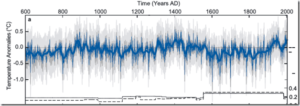by Jim Steele, August 22, 2019 in WUWT
What’s Natural?
Published in Pacifica. Tribune August 20,2019
This summer I taught a class on the Natural History of the Sierra Nevada for San Francisco State University’s Sierra Nevada Field Campus. The first day we taught students how to identify the trees. Once students know their trees, they can easily see how tree species vary with elevation, temperature, moisture, and snow pack. They can see which species colonize open sunny areas and which trees need shade before they can invade. Old time naturalists used trees to identify “life-zones” where different species of mammals, birds, insects and other plants can be found. Furthermore, when you listen to the trees, you can see change.
…
Tree rings indicate the warmest decades of the 20th century were the 1930s and 40s, and temperatures have yet to surpass those decades. This divergence between thermometers and trees is best explained by the fact that instrumental temperatures are biased upwards when taken at hot airports or in areas recently suffering from growing urban heat island effects. In contrast, trees measure temperatures in natural habitat.
…

